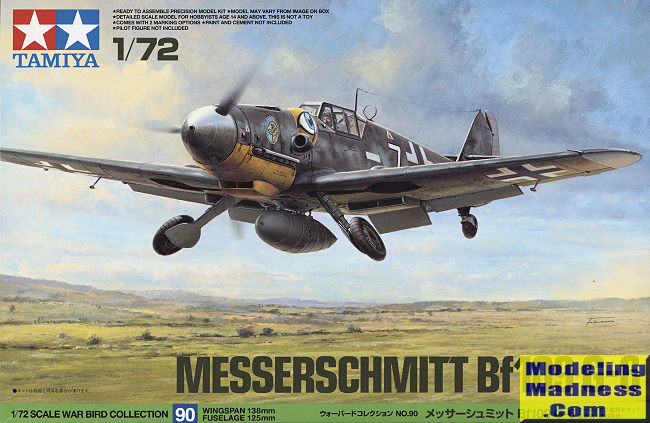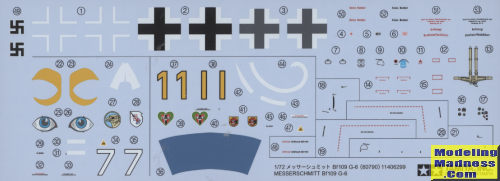
Tamiya 1/72 Bf-109G-6
| KIT #: | 60790 |
| PRICE: | 1700 yen SRP (about $15.60) |
| DECALS: | Two options |
| REVIEWER: | Scott Van Aken |
| NOTES: | 2019 tooling |

| HISTORY |
Without belaboring the point, the Bf-109 was the most built German fighter of WWII. It was designed to put the smallest airframe possible behind the most powerful engine available at the time and was modified continually until the end of the war. This is despite the FW-190 being a newer design and more capable aircraft. What kept the 109 in production is that it was easy to build and easy to repair, despite its lack of maneuverability (thanks to fairly high wing loading) and the treacherously narrow main landing gear.
| THE KIT |
One thing about Tamiya is that if they release a kit in 1/48 scale, the odds are fairly good that they will do the same in 1/72. This doesn't always come to pass, but it often does. This is especially true if the subject is one that historically sells quite well. Such is the case of the Bf-109. Some have said that tooling a new 109 kit is like printing money as they are one of those types that sell well. Do we NEED another 1/72 Bf-109G? Probably not, but if you are going to build a 109, it is wise to do one from a company that provides excellent engineering and good detail as well.
Now I know many of you are thinking that Airfix recently did a new tool 109G and if you've seen it you know they made some major errors on it. The Fine Molds kits are the previous kings of 1/72 109s, but they tend to be a bit on the pricey side, though are still the choice of many for the later 109s.
This kit was well chosen as the G-6 was the most widely built variant and a look at the parts breakdown shows that there could be other variations on the theme. I say 'could' as Tamiya is not all that well known for producing multiple variations of a kit. However, today's market is such that it is wise to plan for a possible future in this regard.
First thing I noticed is that the mounting tabs for parts are fairly hefty in some cases. This ensure proper alignment of pieces and cuts back on the 'fiddly' aspect a kit can have. The cockpit is very nicely appointed and you have good sidewall detail with several bits to attach there upon. Decals are an additional item for the instrument panel and for the seat harness. Of interest is that when joining the fuselage halves together, the instructions tell you not to fill the seams as the actual plane has a seam there (though it is very faint and quite difficult to see in photos.
With the fuselage together, one adds the cowling bits. This is an interesting engineering situation as the upper cowling pieces fit into recesses. The upper cowling area with the gun troughs is separate. Lower cowling has tabs to help position it in place. I like that the exhaust are able to be installed after painting is done. At the back, the fin/rudder is one piece as is the tailplane assembly. This will allow taller and differently shaped fin/rudder pieces to be included if Tamiya decides to do a late G-6.
Wings are the usual single lower piece with separate upper halves. There are reinforcements in the lower wing to prevent any warping while the wheel clearance bumps on the upper wing are molded in place. The lower wing also has areas where holes can be opened up for the underwing cannon pods, though these are not included. Radiators are molded in the lower wing and one simply applies the covers. Note that this kit does not have separate flaps, ailerons or radiator cooling doors. Landing gear is similar to the 1/48 kit ad should be quite a positive fit. There is a separate lower center section to the wing which helps to hide some of the gear sections and is where one attaches the drop tank mount.
You have two different gun sights, depending on the markings option you choose. Canopy, windscreen and backlight are all separate bits and you can pose the canopy open. The prop is held on the prop shaft by a poly cap and this is trapped between a spinner and backing plate. Last item to add is the pitot tube, which also incorporates a tiny section of the lower wing.
 Instructions
are top notch though they only offer Tamiya paint numbers. However, most
Luftwaffe modelers will have a stash of the proper schemes. Both options are in
a base of RLM 74/75/76 with yellow lower cowlings. The box art plane is with JG
51 in the Mediterranean theater so has a white rudder and lower wing tips. The
white fuselage band on this has been overpainted in one of the upper surface
greys. The other is with JG.54 in early 1944. This plane has a blue Reich
Defense band and a white spinner on the prop. It also has a yellow rudder. Why
Tamiya has to mix paint to get the RLM 04 for the yellow is unknown, but clearly
shown. The decals themselves are nicely printed and should offer no issues.
Instructions
are top notch though they only offer Tamiya paint numbers. However, most
Luftwaffe modelers will have a stash of the proper schemes. Both options are in
a base of RLM 74/75/76 with yellow lower cowlings. The box art plane is with JG
51 in the Mediterranean theater so has a white rudder and lower wing tips. The
white fuselage band on this has been overpainted in one of the upper surface
greys. The other is with JG.54 in early 1944. This plane has a blue Reich
Defense band and a white spinner on the prop. It also has a yellow rudder. Why
Tamiya has to mix paint to get the RLM 04 for the yellow is unknown, but clearly
shown. The decals themselves are nicely printed and should offer no issues.
| CONCLUSIONS |
There you have it. Another 'unneeded' model kit that will sell very well and provide funds for Tamiya to produce another kit. It will also spur aftermarket people to do resin sets and decal sheets for it, so it can't be all bad, eh?
June 2019 Copyright ModelingMadness.com.
All rights reserved. If you would like your product reviewed fairly and
fairly quickly, please
contact
the editor
or see other details in the
Note to
Contributors.
Back to the Main Page
Back to the Review
Index Page
Back to the Previews Index Page